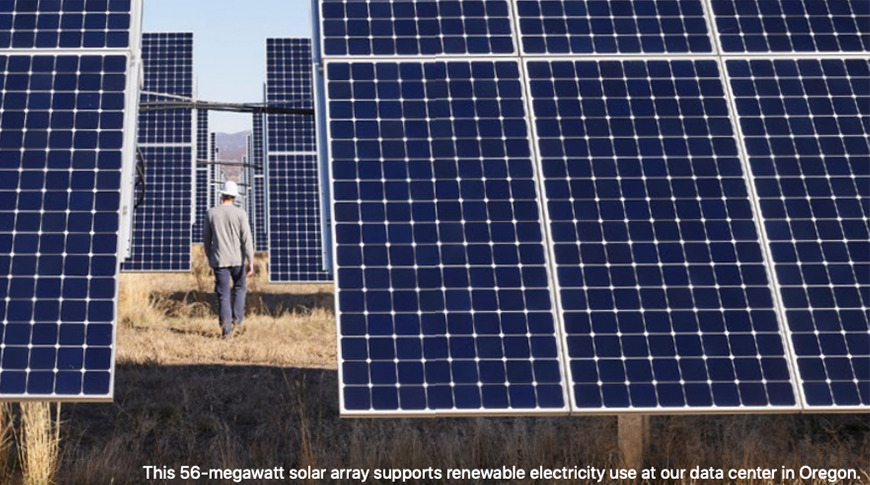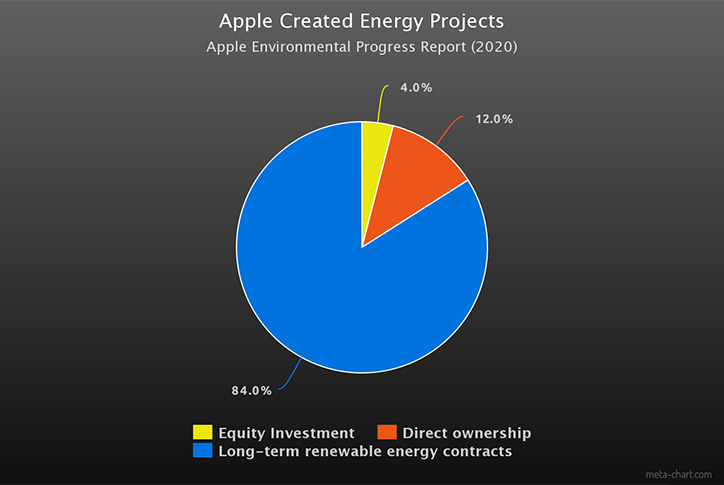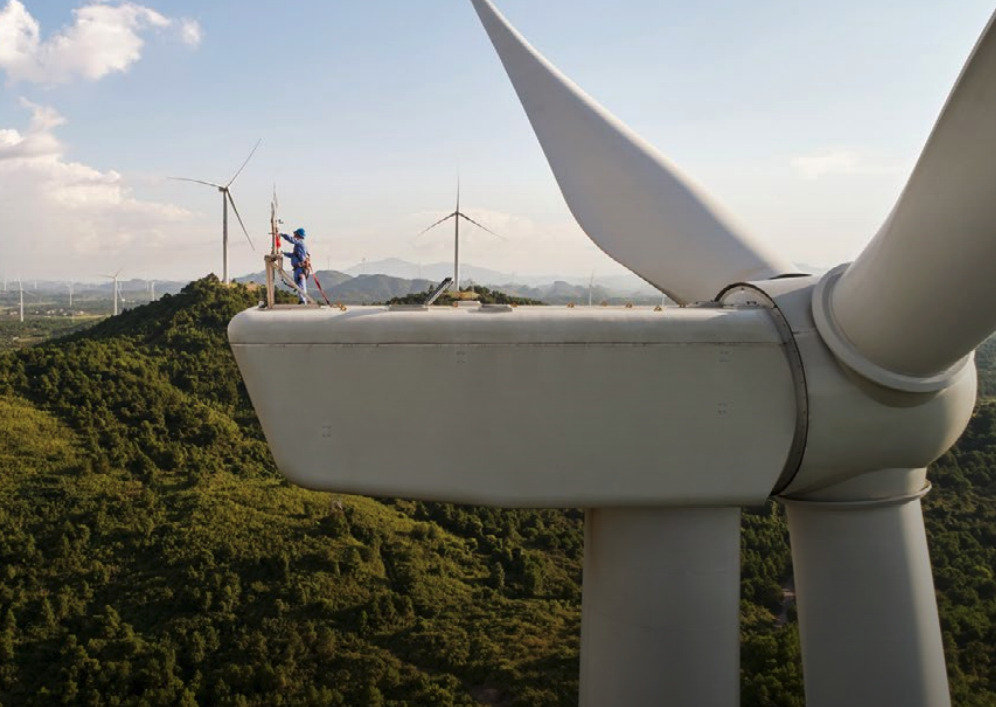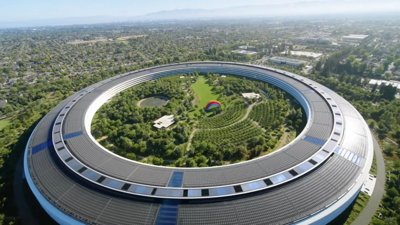Apple released its annual Environmental Progress Report on Tuesday, showing how the company continues to strive toward being carbon neutral.
In 2018, Apple was able to claim that their data centers, distribution centers, retail stores, and corporate offices all run on 100% renewable energy. Over 83% of the renewable energy that Apple sourced up to January 2020 — equal to 1.2 gigawatts — comes from Apple-created projects.
To put that into perspective — the average American uses a little over 10,000 kilowatts of electricity a year. It would take an individual nearly 120 years to consume 1.2 gigawatts of power at our current per capita rate.
Apple broadly classifies an 'Apple-created' project" in three categories.
The largest category by far is Apple's long-term renewable energy contracts. While this means that technically the energy provided to their companies may come from fossil fuels, a large portion of the money they spend goes into research, development, and eventual deployment of local renewable energy projects, such as solar and wind farms.
The second-largest category is Apple's directly owned projects. Whenever possible, Apple builds its own renewable energy projects. Projects built include solar and wind farms, biogas fuel cells, and low-impact hydro projects.
Their smallest category is equity investment. When Apple can't build its own projects, it uses its capital to invest in renewable energy projects, such as solar photovoltaic farms or wind projects. This enables the company to become part-owner, allowing them to match the renewable generation with their energy use.
Apple states its goal is to cover all of its electric use with Apple-created projects eventually.
As it turns out, Apple isn't satisfied with running on 100% renewable energy. It wants its suppliers to do the same. About 75% of Apple's carbon footprint is in its global supply chain. Of that 75%, about 70% of its emissions come from electricity.
In 2019, Apple began stepping in and encouraging its production partners to do the same. Apple's suppliers are slowly but surely making the leap to greener alternatives to fossil fuels, such as solar, wind, biomass, and hydroelectric. The company has set the goal of having a supply chain that is powered entirely by renewable energy by 2030.
Now, Apple plans on helping the communities around it make steps toward going green as well. In 2019, they launched their "Power for Impact" program, allowing local communities and organizations to access cost-effective, renewable energy. The project has already begun in developing countries where Apple has relatively small energy needs, such as the Philippines, where they've installed a 100-kilowatt rooftop solar panel in an educational facility.
Apple is also encouraging aggregation efforts, like last year's China Clean Energy Fund. By encouraging buyers to band together to purchase renewable energy, it gives smaller companies the chance to access cost-effective renewable energy that they may not be able to access independently.
But these aren't the only steps Apple is taking. One of the most interesting moves Apple has made is voluntary withdrawal away from government-subsidized renewable energy projects.
Government subsidies are crucial for many companies looking to take their first steps into energy efficiency. They also increase the availability, affordability, and efficacy of renewable energy projects.
However, like many subsidies, government-subsidized renewable energy incentives are highly competitive. By removing itself from competing companies' pool, Apple gives other companies a chance to take their first steps toward becoming more environmentally sound.
According to Apple's 2020 Environmental Progress Report, its subsidy-free, 42-megawatt solar photovoltaic project in Denmark entered service in late 2019. This project powers its new Viborg data center with 100% renewable energy and has done so since day one.
Apple is also encouraging the Chinese renewable market to transition from subsidized Feed-in-Tariffs to non-subsidized grid-parity projects.
Apple's dedication to offsetting it's impact on the environment is admirable and consistently sets the bar high for its competitors. Many environmental agencies and advocates have taken notice as well.
"Greenpeace USA welcomes Apple's commitment to reduce its carbon emissions to help prevent further catastrophic climate change— the impacts of which will fall most on Black, Brown, and Indigenous communities," Greenpeace USA Senior Corporate Campaigner, Elizabeth Jardim said. "This commitment is a significant step up from what we've seen from Apple in the past.
Of course, Apple benefits from these efforts as well. Aside from the benefits to the environment, Apple's fanbase often cites its corporate compassion and responsibility as a reason to continue to buy from them.
 Amber Neely
Amber Neely









-m.jpg)






 Malcolm Owen
Malcolm Owen
 Mike Wuerthele
Mike Wuerthele
 Andrew Orr
Andrew Orr
 Andrew O'Hara
Andrew O'Hara

 William Gallagher
William Gallagher

 Christine McKee
Christine McKee




-m.jpg)



8 Comments
PLEASE! No more ass-ugly giant white monoliths across our natural scenes! If Apple is truly going no-carbon (of course it uses a lot of carbon to make no-carbon production devices), please stick with solar, hydro, and nuclear. So many of our beautiful western vistas are now destroyed by the need of Seattle and the I-5 Corridor down through California to have windmills to make their power (especially when we have a surplus already of hydro and nuclear).
You may want to fact-check the statement: “The largest category by far is Apple's long-term renewable energy contracts. While this means that technically the energy provided to their companies may come from fossil fuels, a large portion of the money they spend goes into research, development, and eventual deployment of local renewable energy projects, such as solar and wind farms.” A long-term renewable energy contract is where you buy the output of a renewable energy project such as solar or wind. It does not involve purchasing fossil fuel power and then investing in ‘research, development, and eventual deployment of local renewable energy.’ It is a direct purchase of renewal power from a renewable source.